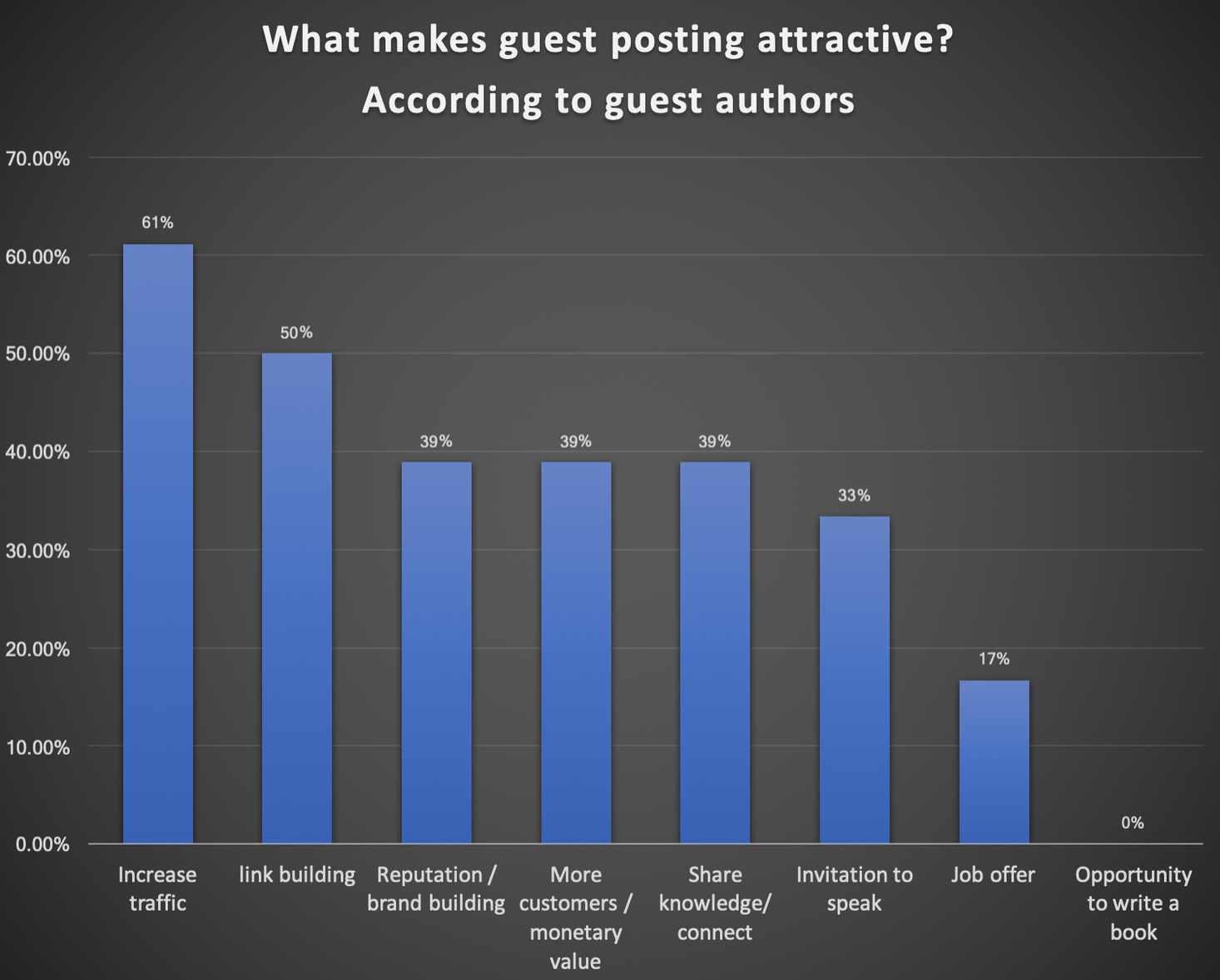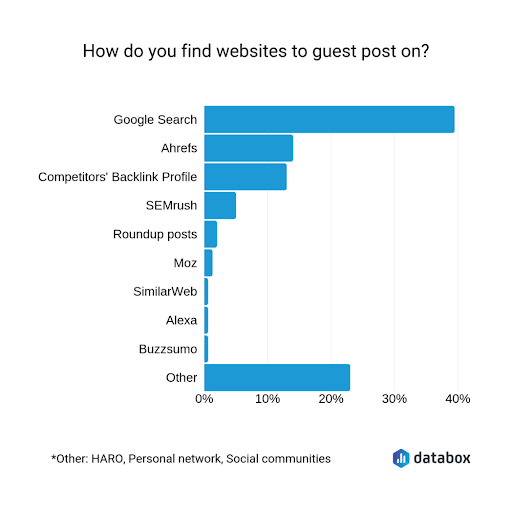Sending your data to our servers, please wait...





Oops... No results found.
Please try a different search phrase.
SEO 13 min read
Guest Posting Best Practices: Galactic Fed's Ultimate Guide
Written by Ayesha Renyard
Content Writer @ Galactic Fed
Expert reviewed by Kat Sarmiento
Associate VP of Operations @ Galactic Fed
Published 12 Jan 2022
If you’re a business owner, you’re busy. You’ve got umpteen tasks to do in a day, so it’s all about shaving the workload, not adding more to it. So many ask us: “Guest posting—is it even worth it?”
Guest posting or guest blogging is the act of writing and publishing an article on another company’s website.
While guest posting may seem like extra work, it can certainly be worth it. It can have an amazing impact on your SEO:
- Attract traffic back to your website
- Boost your domain authority through high-authority backlinks
- Increase your brand credibility and awareness
- Increase your customers/revenue
- Build relationships with peers in your industry

Source: lucatagliaferro.com
With that said, to reap these benefits, you need to follow certain best practices. Working with spammy websites to merely create backlinks could actually hurt your SEO, credibility, and traffic. No payoff there.
Luckily, you don’t need to hunt down these tried-and-true tactics. As part of our SEO Series, here is our guest posting guide with four best practices that’ll get you the results you’re looking for.
1. Identify the Right Guest Posting Opportunities
You want to contribute to websites that’ll create the best return for your company. To weed out the good ones from the bad, here are some factors you’ll want to consider:
- Industry/niche: While you don’t want to contribute to your competitors, you want to tap into an audience that’s similar to yours. So if you own a healthy meal prep company, you won’t reach out to another meal prep company, but you could reach out to a food blogger.
- High domain authority: Domain authority is a search engine ranking score (from 1-100) developed by Moz that predicts how likely a website is to rank in the search engine results pages (SERPs). Use Moz’s domain analysis tool to assess their domain authority. The higher, the better.
- Social following and activity: Are they active on social media? Do they have a large following that would be interested in your product or service? You want to engage a company with a large audience—and social followers are a huge component of that.
- Readership: It’s also essential that the blog has a large readership. Scoping out the blog’s engagement (likes, comments, shares, posting frequency) can help assess this.
To filter out bad opportunities, avoid websites with low domain authority, engagement, and audience reach. This likely means that both SEO crawlers and real people view their content and website experience as low quality or spammy.
How to find the right guest blogging opportunities
It’s all fine and dandy to hear what good guest blog opportunities look like—but how do you find them? As the graph below shows, many use Google Search or marketing tools to uncover these websites.

Source: Databox
Today, we’re going to dig into four of our favorite methods:
Google Research: Google is a great place to start. Simply replace the following keywords with keywords from your industry to begin searching for guest posting opportunities:
- [keyword] “submit a guest post”
- [keyword] “guest post”
- [keyword] “accepting guest posts”
- [keyword] “guest post by”
- [keyword] “guest post guidelines”
If companies are actively looking for guest posts, these searches should lead you to a company’s guest post guidelines page, submission page, or actual guest posts by other writers.
Competitor Research: You can also find great guest post opportunities by looking up your competitors’ guest posts. To do this, use a backlink audit tool like Ahrefs. These tools will reveal their inbound links. If these websites were willing to publish content from your competitors, there’s a high chance they’ll hear your pitch too.
Influencer Research: Influencer marketing is huge right now—how can you leverage it for your guest posting? Tap into their network. Find an influencer in your niche who publishes guest posts frequently and target the sites they guest blog on. If you don’t already know some, simply Google: “Guest post” + [influencer name].
Buzzsumo Research: Buzzsumo, a content analyzer tool, isn’t just great for brainstorming content ideas, it’s also super handy for your guest posting strategy. On the left sidebar, go to “Content-Type” and check off “Guest Posts.” Next, search for your target keywords. Buzzsumo will then show top-performing guest posts.
Source: Semrush
Also among the best guest posting services is Guest Post Tracker which also helps to connect website owners with prospects.
Social Media: Look for guest post call-outs on platforms like Twitter or LinkedIn. A simple search of “guest post” can yield surprisingly good results.
Networking: Keep in touch with people in your niche and industry to explore mutually beneficial opportunities.
2. Personalize Your Pitch
Quality guest posts are important to you—and the company you’re trying to collaborate with. They don’t want to be affiliated with low-quality or irrelevant posts or websites either—it could hurt their domain authority.
To show your interest—and the relevance and quality of your posts—you need to tailor your email to each company. Showing them that you care and you’ve done your research will work wonders for your guest posting strategy.
Here are two small moves that’ll make a big impact on your email pitch:
1. Address the email to the appropriate person: While this gesture may seem insignificant, emails addressed generically are often viewed as spam. Spend a bit of time looking up their blog and identifying the blog owners. Typically these folks are in the content marketing department.
Finding their emails on the website may be tricky. Luckily, tools like Interseller.io or AnyMailFinder can help dig up this information. With Interseller.io, all you need to do is enter your target’s name and domain name, and it will do the rest.
Source: Semrush
2. Research the blog: Take a look at the topics they like to post about and the types of content they create. Is it short-form or long-form? Do they favor formats like listicles? What’s their tone of voice? Hitting these points will buff up your pitch. You can also use Buzzsumo to research their top-performing blog posts to get an indication of what content they’ll be eager to publish.
Then, when writing your pitch, refer back to some of their current content pieces and how yours will complement and align with their blog. Don’t hesitate to provide samples or an outline.
Here is a cold email template to make sure you check off these boxes:
Hi [Name],
[Personalized comment].
I’m writing to you because I’m interested in contributing a guest post on your site.
Based on what has worked for [their site name] in the past, I feel that your readers would love these ideas:
- [Idea Title #1] [Brief Description]
- [Idea Title #2] [Brief Description]
- [Idea Title #3] [Brief Description]
To give you an idea of my writing style and quality, here’s a post I recently wrote: [post link].
Do you think these ideas would be a good fit?
Best,
[Your name]
If you don’t hear from them in a week, send a follow-up email.
Recommended video: For more tips on writing a killer email pitch, watch this quick 10-minute video from Ahrefs:
3. Write a High-Quality Guest Post
It’s time to walk the walk. If this is your first guest post for this company, you’ll want to set the bar high to make a good impression. If you did some solid research on their blog to pitch the topic, then half the work is already done! It’s time to put this knowledge to good use.
Here are five tips to get their stamp of approval:
- First, it’s essential to format your guest post the same way that they do theirs—so it fits in seamlessly. Do they break up their content with lists, subheadings, bolded fonts? These are all ways you can mirror their content.
- Similarly, it’s important to mimic their tone of voice. Do they write for a highly advanced audience, or do they keep words and sentences simple? If you’re not sure, we always recommend writing copy that’s easy to read.
- We also recommend adding internal links (from the same domain) to the piece. This increases its quality and adds visibility. Win-win.
- If you really want to make your content stand out, consider including custom images. Few guest bloggers bother to create high-quality images for guest posts. If you take the time to do this, your content will immediately stand out (and earn instant approval).
- Don’t forget to add a call-to-action at the end of the post! Encouraging comments and shares will boost engagement and visibility—and signal to SEO crawlers that the post is high-quality stuff.
At this point, it’s time to consider your side of the bargain as well. While your guest post shouldn’t be overly promotional, it should also create a clear path back to your website. Here’s how you can do that:
- First, look for opportunities to add contextual backlinks to help drive traffic back to your site. Contextual links are pieces of clickable text (usually a keyword) located in the body of a paragraph containing similar text ideas. As we’ve preached many times, links drive growth (see what I did here), so it’s important to seed them when you can.
- Take time to write your author bio. Some companies may make changes to the main body of your post, whereas your bio should remain intact. So take advantage—spend a couple of sentences introducing yourself and your qualifications. Most importantly, include a link to your blog for more related content. The one below is a great example of a guest blogger bio.

Source: Bloggingwizard
4. Have a Plan for Promotion
You’ve done the work to write a stellar guest post, and it’s now published on their blog—but you’re not done yet. This final tactic is just as important as the others, but it’s often overlooked. To get the most mileage out of your guest post, you need to promote it.
Promotion isn’t just about gaining visibility for this one post—it also increases your brand’s visibility and grows your relationship with the company you’re working with. It may even open up new guest posting opportunities.
There are many ways you can promote your guest piece:
- Share on social: This one is super simple. Choose the social networks that you’re most active on and have the most followers. Don’t forget to tag the partnering company so they can engage with the post as well.
If you’re sharing on Twitter, create a thread and share more of your related content. If readers like this post, make it easy for them to find more of your work.
- Submit to online communities: Niche groups and community boards are excellent platforms for tapping into interested audiences. Writing about eco-friendly products? Share the link to boards and communities that care about the environment. Just make sure the post doesn’t sound overly promotional, or it’ll get flagged as spam. Be genuine!
- Send to email subscribers: If you’ve got a hefty email subscriber list, don’t hesitate to share this piece of content with them. After all, they’ve already demonstrated they’re interested in what you have to say and offer.
- Add the link to upcoming content: You should always look for ways to create high-quality links to increase your SEO. Keep this link on your radar and work it into a future content piece of yours.
- Add the link to evergreen content: Updating your old content is an easy way to boost SEO. If you have any old related content, add this link to it!
It’s Time to Add Guest Blogger to Your Resume
That’s right, you have everything you need to become a guest blogger. With these best practices, you’re on the right path to build brand visibility, boost traffic, increase SEO and score more readers and prospects with your guest post.
Sure, it’s work—but it’s worth it.
If you’ve got more questions, don’t hesitate to speak with our team of specialists. There’s certainly more where this came from!

Ayesha Renyard
Content Writer @ Galactic Fed



